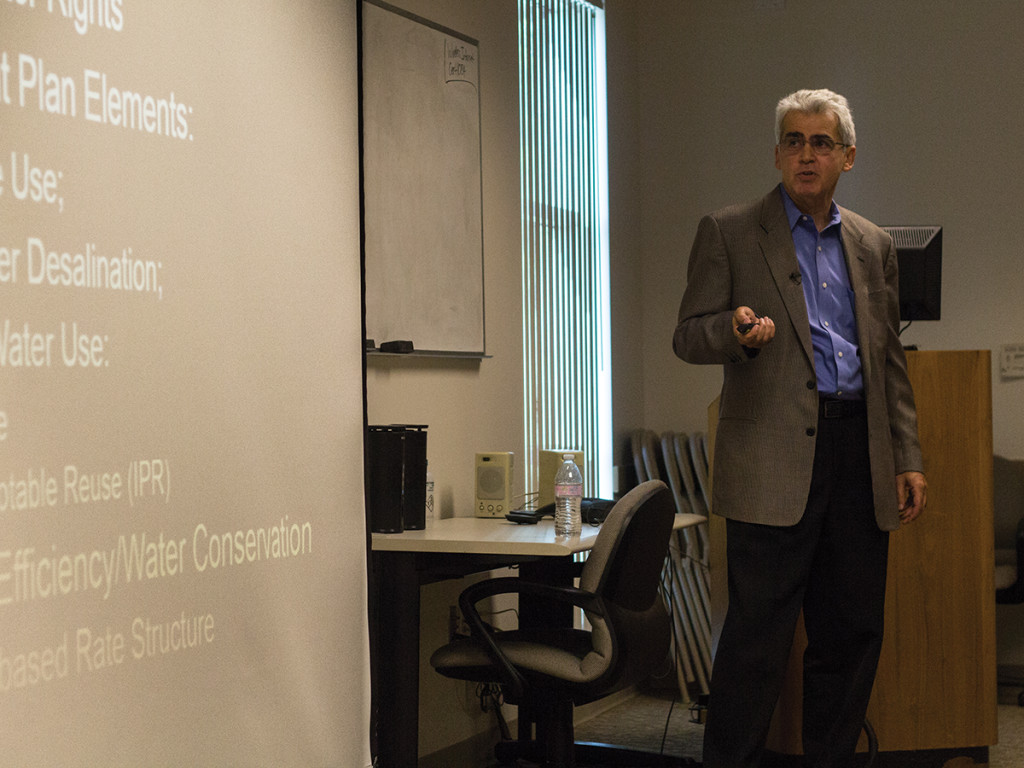
On Thursday, May 19, Principal of Water Resources Engineers Inc., Behrooz Mortazavi, spoke to Riverside residents about the valuable resource that groundwater can be in mitigating the four-year California drought. The lecture, which took place in the Center for Environmental Research & Technology, was one in a series of Randall Lewis seminars, which are programs that are free to the public and “cover a wide range of regional sustainability topics such as air and water quality.”
The California drought has exacerbated the state water supply, as a sizable percentage of water is evaporating and useful snowpack is melting. State lawmakers have imposed conservation laws as a response to this shortcoming, but the water supply is still more expensive and considered to be unreliable.
To demonstrate the degree of severity that the drought has reached, Mortazavi showed a chart comparing the hydrology — or the science of the properties and distributions of water on Earth — of California’s water supply from 1961-1990 to the projected water supply between the period of 2020-2049. On the vertical axis was the rate of gas emissions that affects climate change and further affects the rate of melting in snowpack, which is the collective mass of California snow that supplies about one-third of California’s water needs.
From 1961-1990, California lost 20 percent of snowpack, a number that is expected to double between the years 2020 and 2049.
Not only did Mortazavi analyze the decreasing level of clean water, but he also addressed the issue of lower water quality. According to Mortazavi, although Californian citizens are demanding more water, the water we pump is “less and less good quality and more and more bad quality.”
Water is considered “bad quality” if it is pumped at a faster rate than it would naturally be replaced, such as through precipitation. Consequently, the purity of the water declines and efforts to filter the water increases.
As a result of the unstable quality and supply of water from California’s deltas, which are the state’s single most valuable link to freshwater and is negatively impacted by increased evaporation and decreased snowpack, Californians mostly consume water from imported bottles.
Using groundwater could be the solution to the delta’s shortcomings, according to Mortazavi, who also claimed that “water that comes out from the ground … (can be recycled) to use for farming (and) irrigation.” Groundwater is the rainwater that collects beneath the surface of soil and can be purified of contaminants to become clean water. Finding ways to make groundwater more available and efficiently processed, Mortazavi claimed, could subdue the harmful impacts of decreased snowpack and water supply.
One of the solutions that Mortazavi developed on behalf of the Water Resources Engineers Inc. in making the usage of groundwater more widespread is proposing that farmers use recycled groundwater with the incentive being they would only “pay the cost of pumping wells.” Many farmers agreed to follow this plan since they were aware that their water supply is often low due to the unreliability of imported water.
Mortazavi also proposed to implement a tier-based allocation system in which households’ water bills would be based on how sustainable they are. “Each household gets an allocation based on indoor usage (or expected usage based on the number of people in a household) and outdoor (per square foot of lawn),” said Mortazavi.
To assess the effectiveness of the tier-based system, environmental economists Baerenklau, Schwab and Riar performed a study in 2014 that revealed households sustained greater water efficiency for three to four months, a time span that he claimed was indicative of an effective management plan.
During the Q-and-A section, an audience member asked about what could be done with the contaminants extracted from dirty water. Mortazavi offered that even the contaminants can be used for something. Because groundwater is usually high in salinity, the Eastern Municipal Water district, which provides water to the western Riverside area, sends the saline water back to the ocean through pipelines. However, he clarified that groundwater composition is different depending on the area and gave the example of Australia, which uses the salt in groundwater to create roof tiles.
Regarding water management projects in general, another audience member asked how far away we are from implementing projects through grant money. Mortazavi responded with, “It depends on the project, such as its scale, type, where the grant comes from and the objective of the project.” He claimed that, while not all grants are enough for projects because they have differing objectives, it is important to find the right grant for the right project.
Different water management projects require unique guidelines to be properly implemented, for, as Mortazavi stated in the summary section near the end of his speech, “different regions implement different water management plans based on availability of resources and needs.” He then explained that such projects require a culmination of experts, such as climatologists, policymakers, GIS Experts, attorneys, hydrologists, engineers and financiers, which indicates the individuality of each area’s needs.
Mortazavi concluded by stressing that water management is “very data intensive … but (ultimately) people really benefit” because studies, such as the one performed by Baerenklau, Schwab and Riar, prove that management projects increase the quantity of fresh California water.








